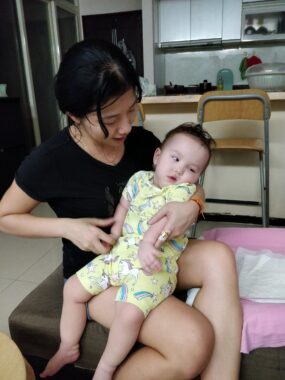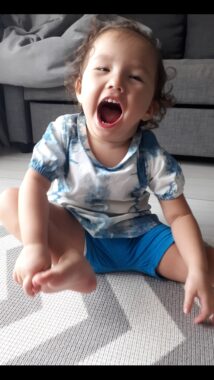Naughty behavior is a luxury with an AADC-deficient child
What onlookers don't understand when they see us celebrating
Written by |

Our daughter throws a toy across the room or whines about not having an iPad before plopping her hands in her food at dinnertime. While these frustrating behaviors are an annoyance, they’re also a luxury we’re fortunate to deal with.
During an online discussion with other parents whose children received gene therapy, my wife, Judy, and I shared our irritations with our child’s negative behaviors. We laughed and nodded with understanding as each parent shared similar situations.
Resetting the clock
When our daughter, Rylae-Ann, was 3 months old, she began missing her milestones. Later, we learned this was around the time most parents of children with aromatic l-amino acid decarboxylase (AADC) deficiency start becoming alarmed.
Our daughter should’ve been grasping at every little thing within arm’s reach. Instead, she lay motionless with her eyes barely open. Her immobility and inability to open her eyes were a result of the symptoms. After gene therapy, her movement was activated.
Rylae-Ann had gene therapy when she was 18 months old, in November 2019. We refer to this as her “reborn day.” She began to accomplish the typical 3-month-old milestones when she was nearly 3 years old.
So while onlookers may see an older child demonstrating immature actions, we see extraordinary progress.

In October 2019, one month before gene therapy, Rylae-Ann was unable to move but listened to her mom. (Photo by Richard E. Poulin III)
Throwing objects
Rylae-Ann had just learned to sit unassisted. We could place her in a restaurant highchair instead of holding her upright or placing her in her well-cushioned stroller. Sitting on her own was cause for celebration, but Rylae-Ann wasn’t done.
As we ate, she snatched a nearby tantalizing metal fork. Although her grasp was still clumsy, she grabbed ahold of it and flung it across the restaurant floor before we could react.
She giggled with excitement as it clanged across the floor before bubbling even louder as we chased it with bulging eyes. Judy and I celebrated her improved dexterity with cheers once the fork was safely rescued.
This chaos may have annoyed nearby patrons. Why in the world are we encouraging such behavior? Well, the ability to grasp and throw meant she had new muscles she didn’t previously possess. It was a sign of what was possible.

About one year after gene therapy, Rylae-Ann eats independently with her mom at a restaurant in Thailand. (Photo by Richard E. Poulin III)
Screaming words and talking loudly
Before gene therapy, our daughter communicated through crying and laughter. Although our family had begun to distinguish a cry of fear from a shout for a nappy change, communication was extremely limited. She didn’t understand us, and we had trouble understanding her.
After finding a speech therapy program, my wife dedicated daily sessions to helping our daughter talk. Over time, barely discernible words became phrases. Today, those phrases are complete sentences.
Vocabulary is a prominent component of speech therapy, but so is volume control. Although Rylae-Ann could begin to produce words, she was barely audible due to her weak core muscles. With a combination of speech and physical therapy, her articulation muscles grew stronger, and she discovered the power of voice.
As a result, she can now better express herself and get our immediate attention. In public places, her excitement encourages her to share her voice. Often, others are surprised by her sudden release of decibels. Most laugh, but some roll their eyes.
To us, her loud screams are an accomplishment of daily speech therapy efforts and a sign that our family is fortunate to be able to talk with one another.

Rylae-Ann sits independently while loudly singing a song. (Photo by Richard E. Poulin III)
Running away
When my wife learned about the prognosis of AADC deficiency, she sobbed into my chest. She wondered if she would ever have the chance to hold her daughter’s hand while walking. I had similar fears, as the rare disease meant she’d likely be bedridden.
Gene therapy provided us an opportunity to change that. The treatment didn’t allow our daughter to walk instantly, but it increased neurotransmitter levels to give her the possibility.
Daily physical and occupational therapy provided barely perceptible progress. Each session was filled with tears and screams. Although it seemed like all our daughter’s efforts were for nothing, we didn’t give up on her.
Over time, she learned to crawl, then stand, and eventually take her first steps. Today, we can’t get her to stop running away. She loves exploring. This free spirit makes it challenging to complete errands efficiently, but for us, it’s a miracle each time we see it.
Other shoppers may wonder why two parents are beaming with pride as their daughter runs around the store, but we can’t help it. It never gets old and is always a moment worth capturing on our phones.
Behavior and manners
Although we celebrate all these new cheeky behaviors, we don’t let them go unchecked. We do our best to give positive feedback and model expectations, but we still must consider her journey.
Rylae-Ann is a little girl fighting against a rare, debilitating disease. She received an experimental treatment that reset her birthday and gave her a chance at life. So although those around us who don’t know her story may see a mischievous girl, we take these naughty behaviors as moments to be treasured.
Note: AADC News is strictly a news and information website about the disease. It does not provide medical advice, diagnosis, or treatment. This content is not intended to be a substitute for professional medical advice, diagnosis, or treatment. Always seek the advice of your physician or other qualified health provider with any questions you may have regarding a medical condition. Never disregard professional medical advice or delay in seeking it because of something you have read on this website. The opinions expressed in this column are not those of AADC News or its parent company, Bionews, and are intended to spark discussion about issues pertaining to aromatic l-amino acid decarboxylase deficiency.






Leave a comment
Fill in the required fields to post. Your email address will not be published.